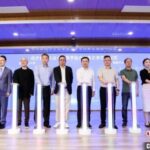Formerly Asia’s largest cement plant has transformed into a new hub for artificial intelligence. Yesterday afternoon, the Xuhui Riverside West Bund Dome Art Center welcomed international guests attending the 37th Shanghai Mayor’s International Business Advisory Council meeting. Under the dome’s canopy, eight companies set up exhibition booths to showcase Shanghai’s latest achievements in artificial intelligence, receiving applause from the business leaders and quietly initiating collaborations between council member companies and Shanghai’s AI enterprises.
«This year, council members have been particularly enthusiastic about attending the Shanghai meeting, and they’re especially interested in China’s artificial intelligence.» At Xuhui Riverside, many Fortune 500 company CEOs noted that few countries in the world possess a complete artificial intelligence industry chain like China does. «Looking to the future, we shouldn’t be complacent, but we should have more confidence. Shanghai’s cooperation with the world will only become closer.»
Witnessing Shanghai’s Latest AI Industry Developments
At Shanghai Jipai Technology’s exhibition booth, the CEO of Yum China Holdings played a smart wireless guitar. This guitar can generate song chords in real-time, allowing complete beginners to quickly learn to play melodies.
After putting down the guitar, she tried on AI translation glasses called «Rokid Glasses.» When people around her spoke Chinese, the lens screen automatically displayed bilingual content in green. The company staff explained that these glasses weigh about the same as regular glasses, can automatically adapt to nearsightedness up to 600 degrees, and have a translation accuracy rate exceeding 90%. «Wonderful!» the CEO nodded in approval.
At Shanghai Fourier Intelligence Technology’s exhibition booth, a council member noticed a rounded humanoid robot.
«It’s so cute!» the council member approached while recording video and waving. This humanoid robot is Fourier’s newly released «GR-3,» featuring soft coating technology and a newly developed full sensory interaction system for more friendly interactive companionship experiences.
«I’m impressed by the depth and breadth of Shanghai’s practical AI applications.» The council member noted that humanoid robots could provide solutions for addressing population aging, and AI could also be applied to healthcare and energy efficiency optimization. The evolution from large models to efficient small models demonstrates the close integration of cutting-edge technology with real economy and social needs.
Creating Opportunities for Further Engagement
After hearing the introduction from United Imaging Intelligence Medical Technology’s co-founder, a special guest speaker didn’t follow the group to the next booth. He exchanged business cards and added WeChat contacts with the co-founder to explore possibilities for further communication and cooperation.
«United Imaging’s multimodal medical large model is particularly interesting. I want to learn more about it.» The professor remarked that Shanghai’s AI development speed from concept to technology integration to solutions far exceeds expectations. «Chinese AI companies excel not only in technological theory but also lead in practical applications. This is just the beginning of the AI revolution. I believe we’ll see more innovation in Shanghai and look forward to Shanghai becoming a center for both international and local technology enterprises.»
While international guests were enthusiastically touring the exhibits, Shanghai’s AI companies were seizing the opportunity. «We usually interact more with these companies’ China regional executives, but this is the first time we’ve encountered so many Fortune 500 CEOs simultaneously.» The vice president of Fourier Intelligence valued this opportunity, bringing their latest humanoid robots, rehabilitation robots, and other «black technologies» to the venue, hoping to capture the foreign guests’ attention within the brief 10-minute presentation window.
Of course, the vice president acknowledged they didn’t expect to immediately secure orders from a single presentation, but rather hoped to make an initial impression and create opportunities for further contact. He was pleased that many Fortune 500 China presidents actively exchanged business cards, with some even staying behind for in-depth discussions after the tour.
Leveraging Global Networks to Support Shanghai Enterprises
Before visiting Shanghai’s AI technology exhibition yesterday afternoon, a council member had toured a collaborative project in Pudong that uses AI technology to save time and improve production efficiency.
«We’ve established an open innovation laboratory in Shanghai. Of course, they face competition from our other global R&D centers, but I believe Shanghai’s team has vitality, innovation willingness, and capability—they always create something new.» The council member expressed confidence in Shanghai’s R&D team.
Another council member believes China and Japan have significant cooperation potential, particularly in Shanghai, where their institution can serve the city’s financial opening and development. «We recently received approval to establish a wholly foreign-owned securities company in China, and we’re very willing to leverage our strong global network to support Shanghai enterprises’ development.»
On site, a special guest had already exchanged contact information with three or four Shanghai


